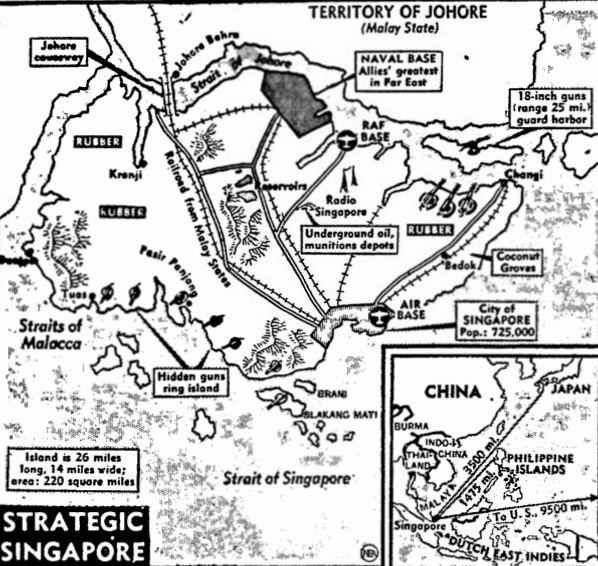The Pittsburgh Press (December 17, 1941)
Land at 3 points –
Japs push back Borneo troops
By Harold Guard, United Press staff writer
Singapore, Dec. 17 –
Japanese expeditionary forces smacked into three points on the oil-rich North Borneo coast today in a new flanking threat to Singapore, but British defenders applied a “scorched-earth” policy in the oil fields and took up strong defensive positions.
The invasion, coupled with an increasingly serious Japanese drive southward from Thailand close to Penang in Malaya, tested to the limit the ability of the Allies to defend the key Singapore naval base, but officials expressed confidence that it could be held.
In London, some sources said it was feared Malaya might be lost but that Singapore could hold out. The British were said to have blown up oil wells producing a million tons a year in North Borneo and the Dutch at Batavia said that oil supplies had been removed or destroyed before the Japanese landed. A Dutch plane blasted a Japanese destroyer off Borneo.
The Japanese landed at three points on a 50-mile stretch of North Borneo coast, all in British or British-protected territory.
The landing points were given as Miri and Lubon off the coast of the protectorate of Sarawak and Seria, in the little Brunei Sultanate farther up the coast.
British detachments withdrew to stronger defense positions, blowing up all oil Wells, refineries and installations as they went. All had been mined in expectation of a Japanese attack.
It was expected here that the Japanese would seek to organize at once during an advance on the oil fields in the Dutch part of the island, and that they would seek to make Borneo, part of the East Indies, a base for attacks on Singapore to the west and the Philippines to the northeast.
Well-informed sources reported that British authorities had made all arrangements to blow up every oil well in the Miri area if necessary.
Penang in danger
The Japanese in Malaya were reported attacking with fanatic determination in face of direct artillery and machine gun fire in a drive down the west coast which was believed now to have reached the Muda River, 10 miles north of Penang Island.
Penang was definitely in danger though strongly defended, and the menace to Singapore from this northern side increased daily.
British forces were fighting stubbornly, however, against superior numbers and it was reported that the Japanese were suffering heaviest casualties.
Fear pincers on Singapore
Dispatches said that coast artillery, field guns and machine guns lined lined the Penang Island shores ready for a direct attack.
The Japanese had fought their way along the flat Kedah coastal plain, a rice-producing country through which runs the main road in almost a straight line through the fields, between swamps in which natives drive their water buffalo. The fields are criss-crossed by canals and small streams.
There were indications that the British forces would try hard to organize a counterattack in an attempt to prevent the Japanese from establishing bases from which they could threaten Netherlands Sumatra and essay a pincer movement by land and sea to surround and immobilize Singapore.
Fight in jungles
The strength of the British forces was their possession of the inland hills, which form a backbone separating the west and east coasts. This is jungle country in which a man can lose himself 50 yards from a road.
Sir Shenton Thomas, Governor of Malaya, disclosed that a British airplane had sunk off the Kota Bharu coast of eastern Malaya two Jap transports which were filled with tanks and enormous invasion barges.
Reports reaching Singapore from up country said the Japanese had extended their grip on a strip of the northeast Malaya coast but that the heaviest fighting continued in the Muda Rover area opposite Penang on the west coast.
Japs cross river
Fighting was described as scattered because of the nature of the plantation-jungle country, but the Japanese were believed to have crossed the Muda River and to be filtering into Province Wellesley, opposite Penang, against stiffening British resistance.
The northeastern coast fighting was of the most confused nature but there were reports that two disjoined British forces had succeeded in remaking contact after heavy fighting.
Reports increasingly emphasized the suicidal nature of many Japanese attacks in the face of direct
Use one-man tanks
At many places, it was said, the Japanese were using one-man tanks.
Royal Air Force headquarters said that the Japanese were using two types of planes in Malaya. One was described as a naval single-seater, the other as a naval type plane armed either with two cannons or with four machine guns. Both are low-winged monoplane fighters.
An official notice was posted here today warning the public that the Japanese in Malaya were provided with “military currency notes,” along the German pattern, and that some had already been circulated.
